Sir John Monash, Personal Files Book 15, 1 April - 10 May 1917, Part 13
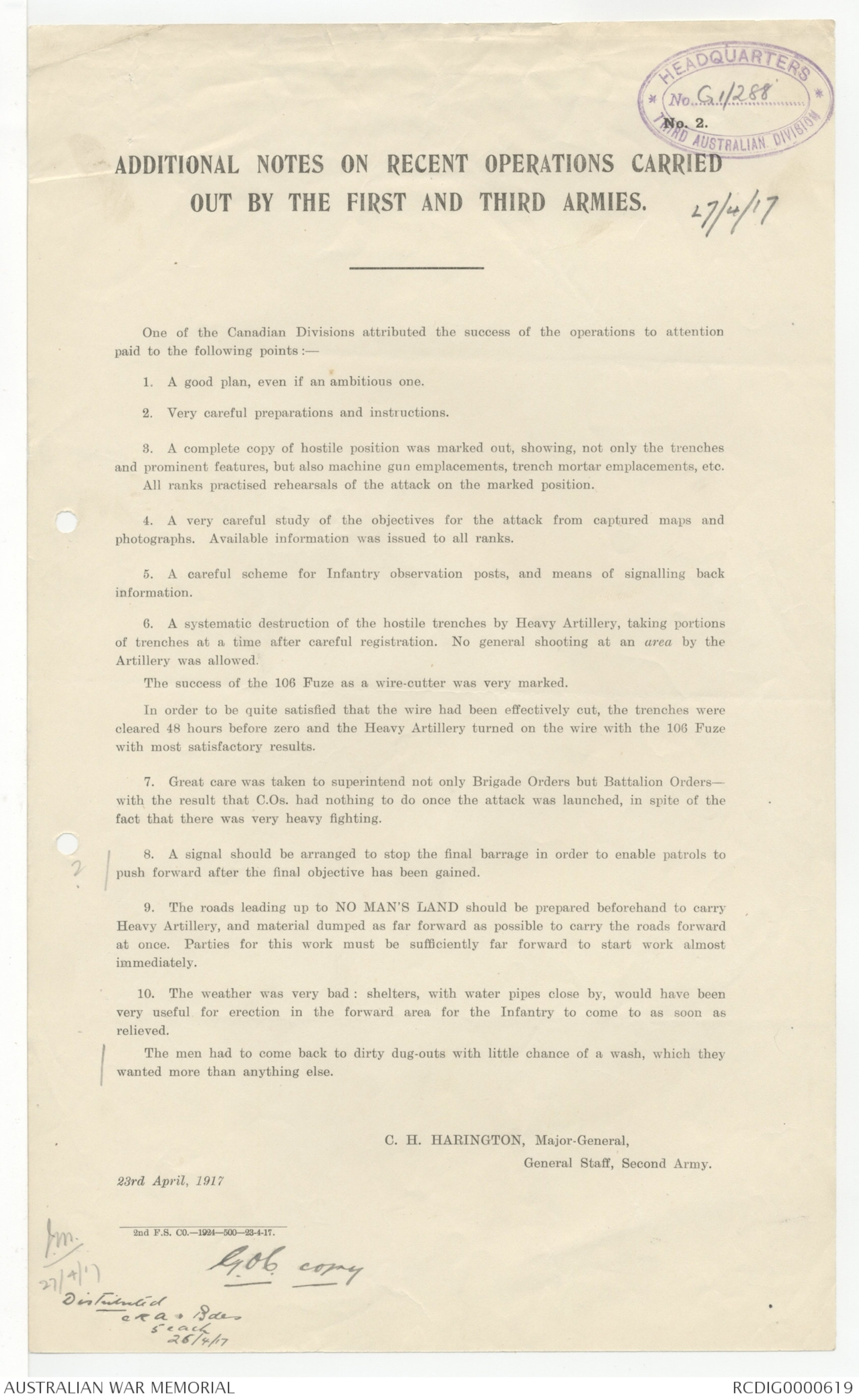
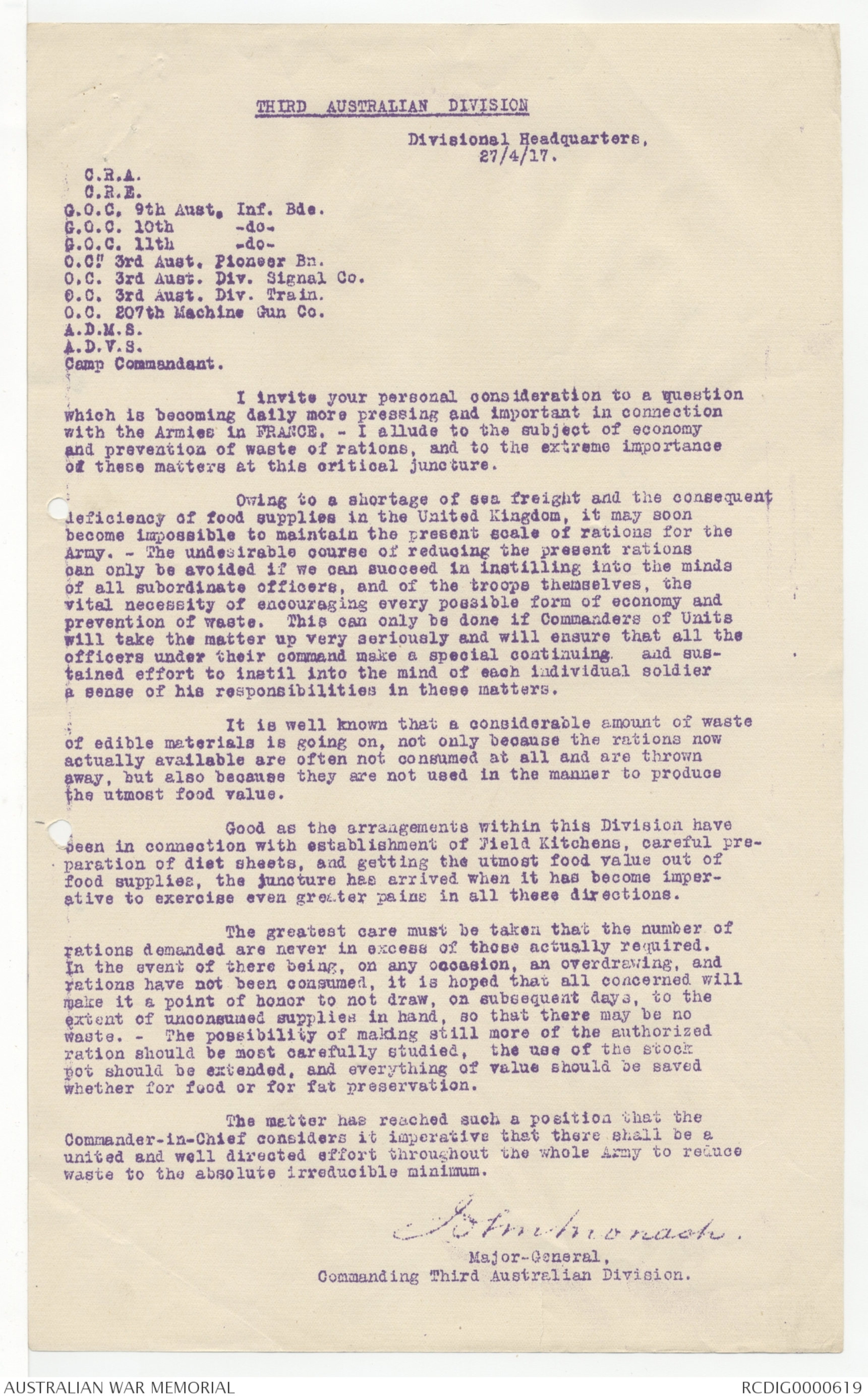
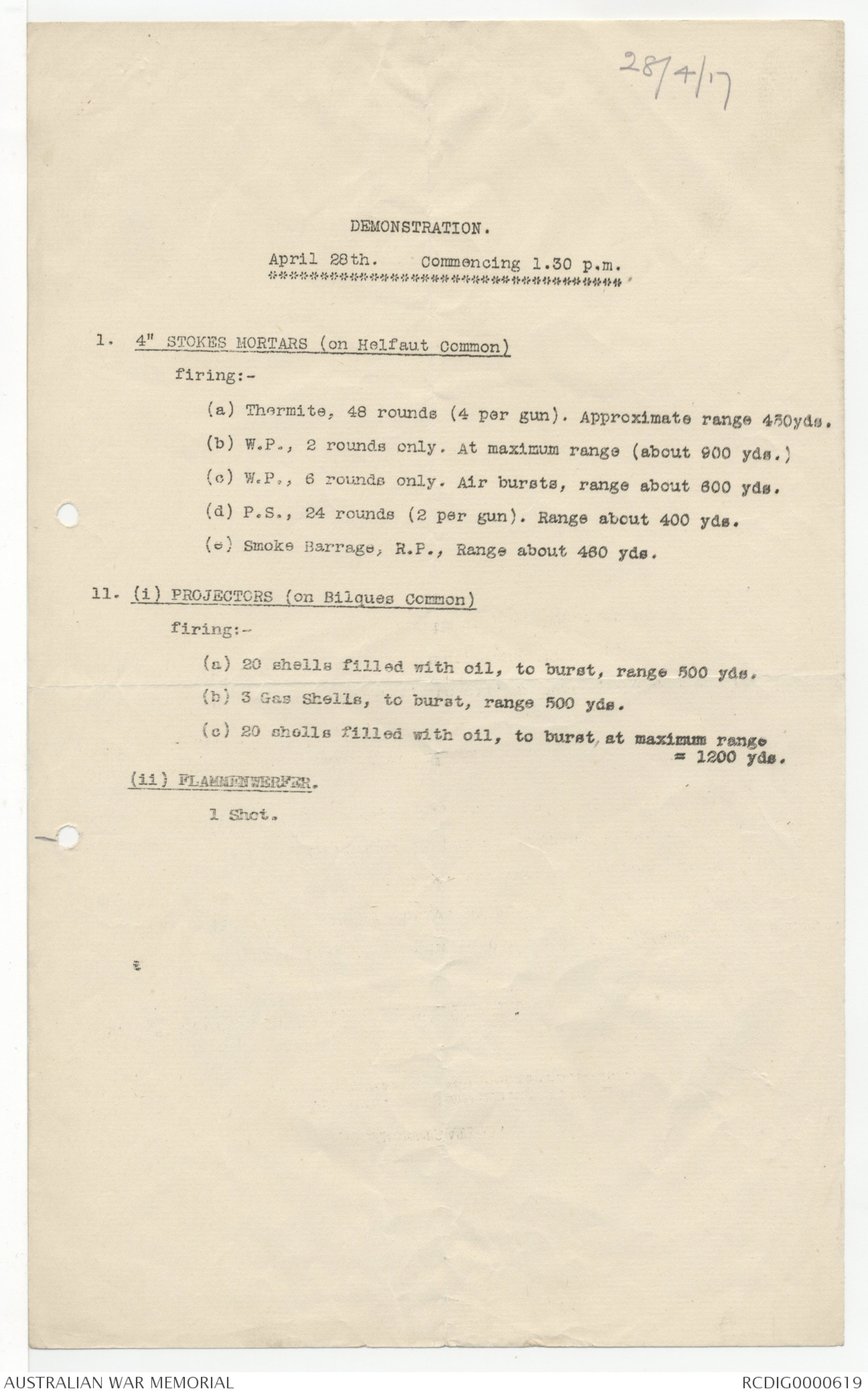
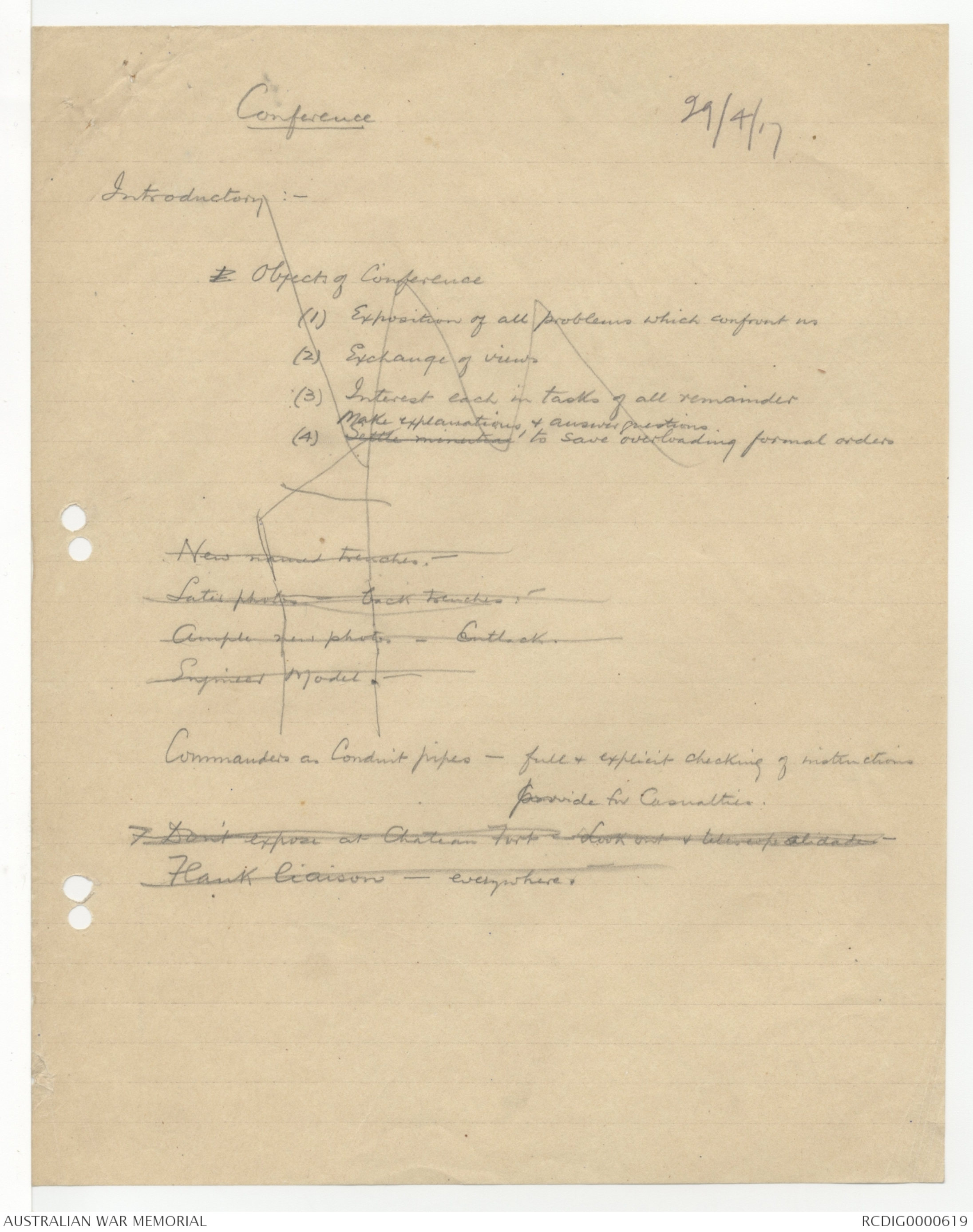
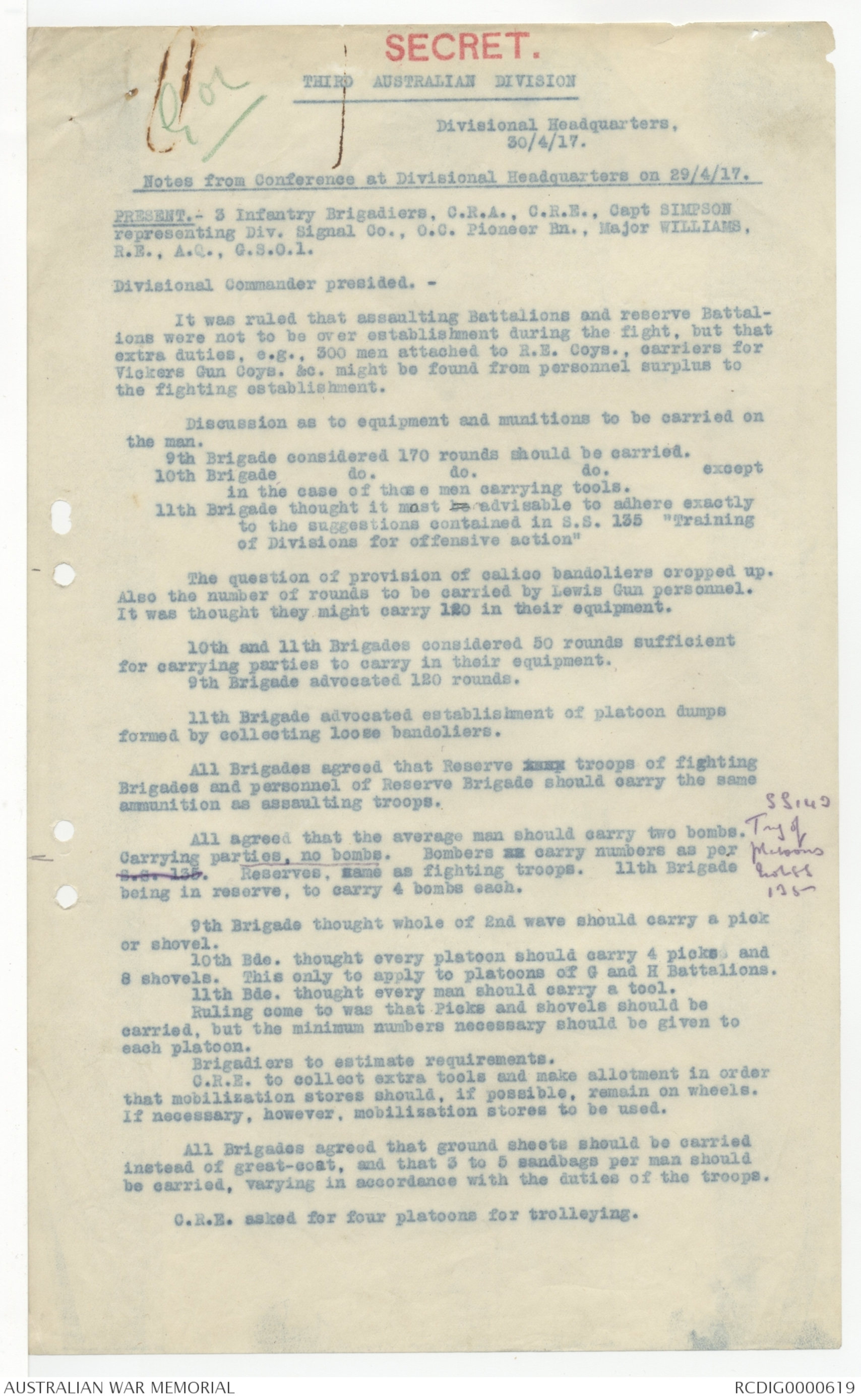
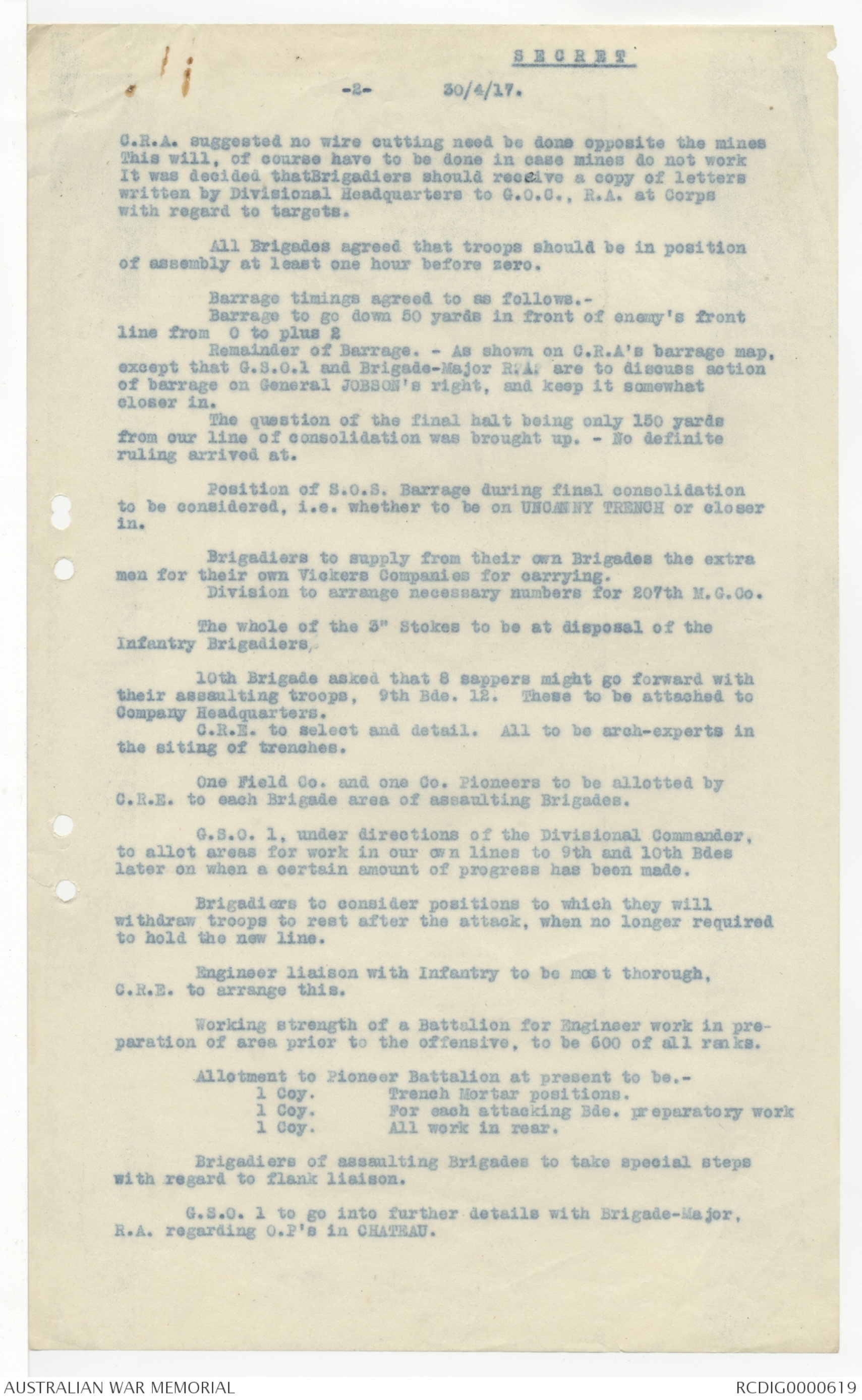
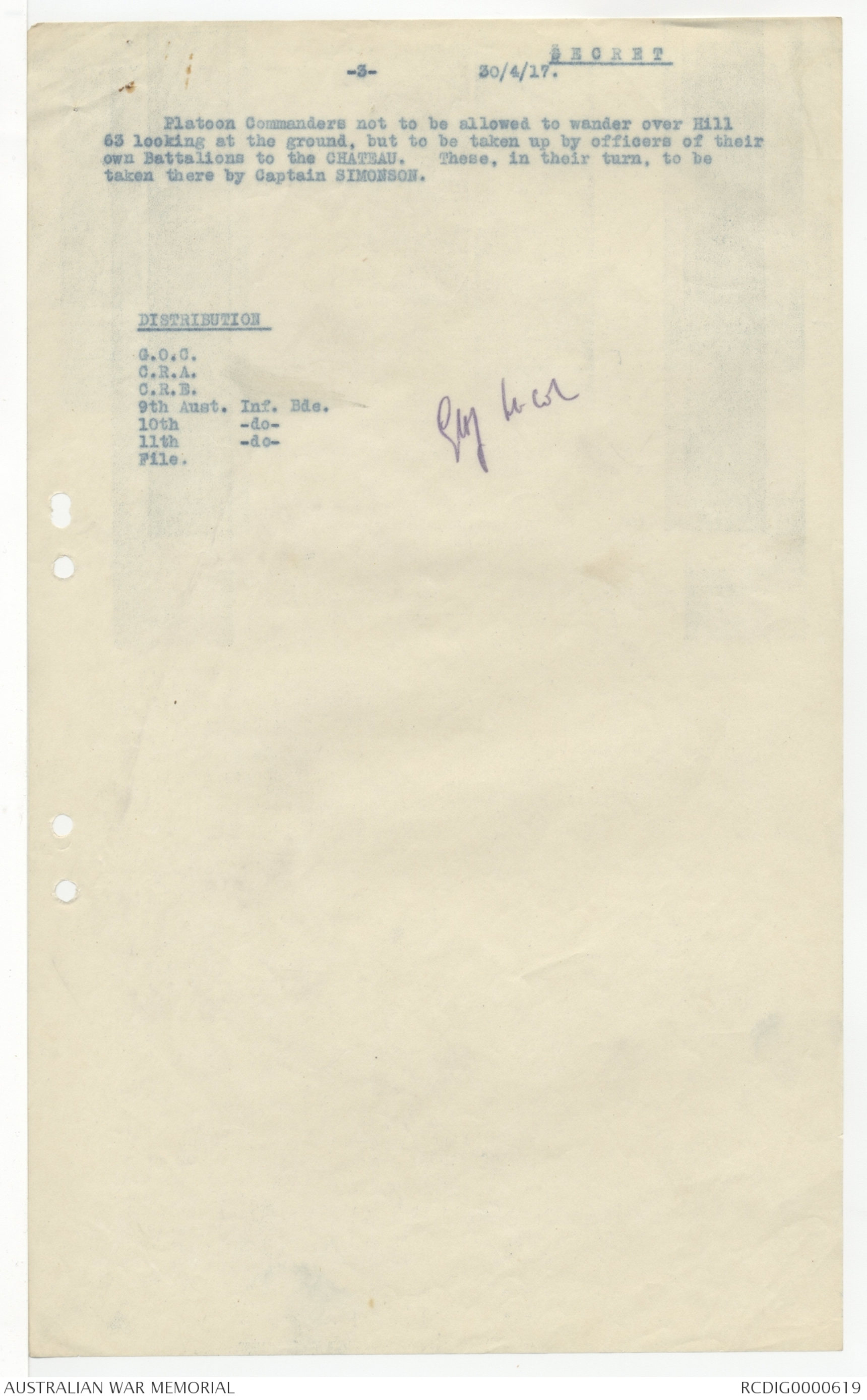
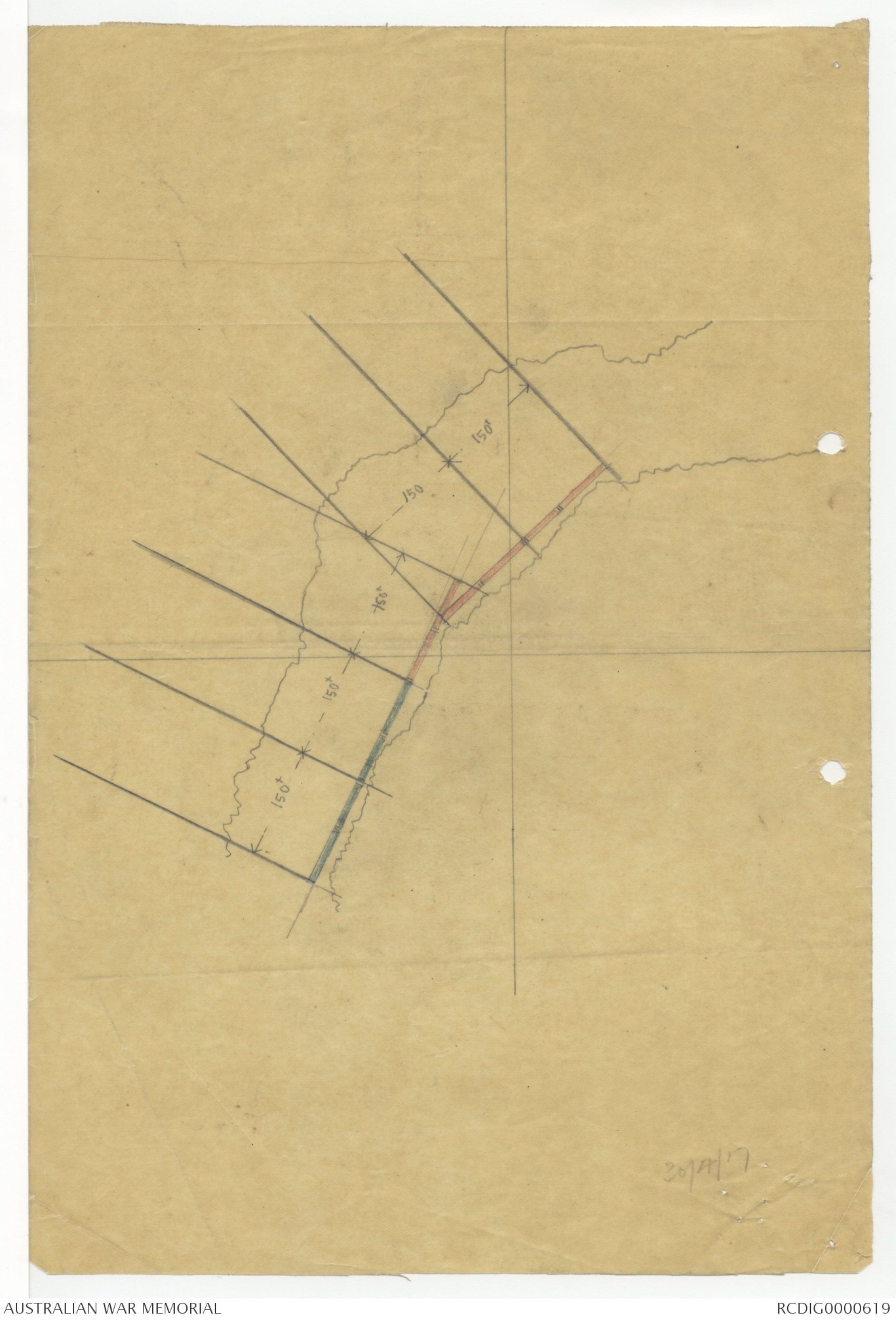
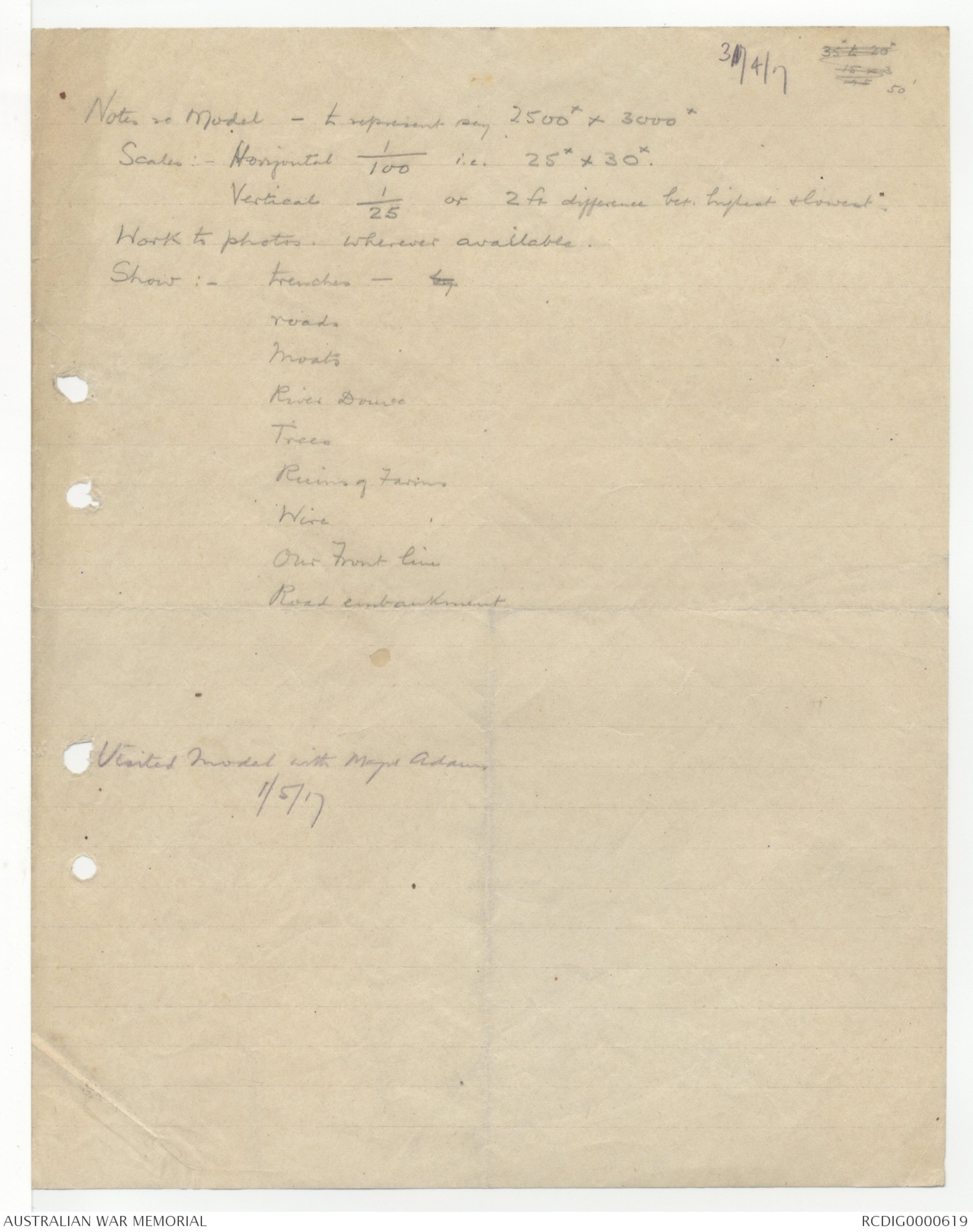
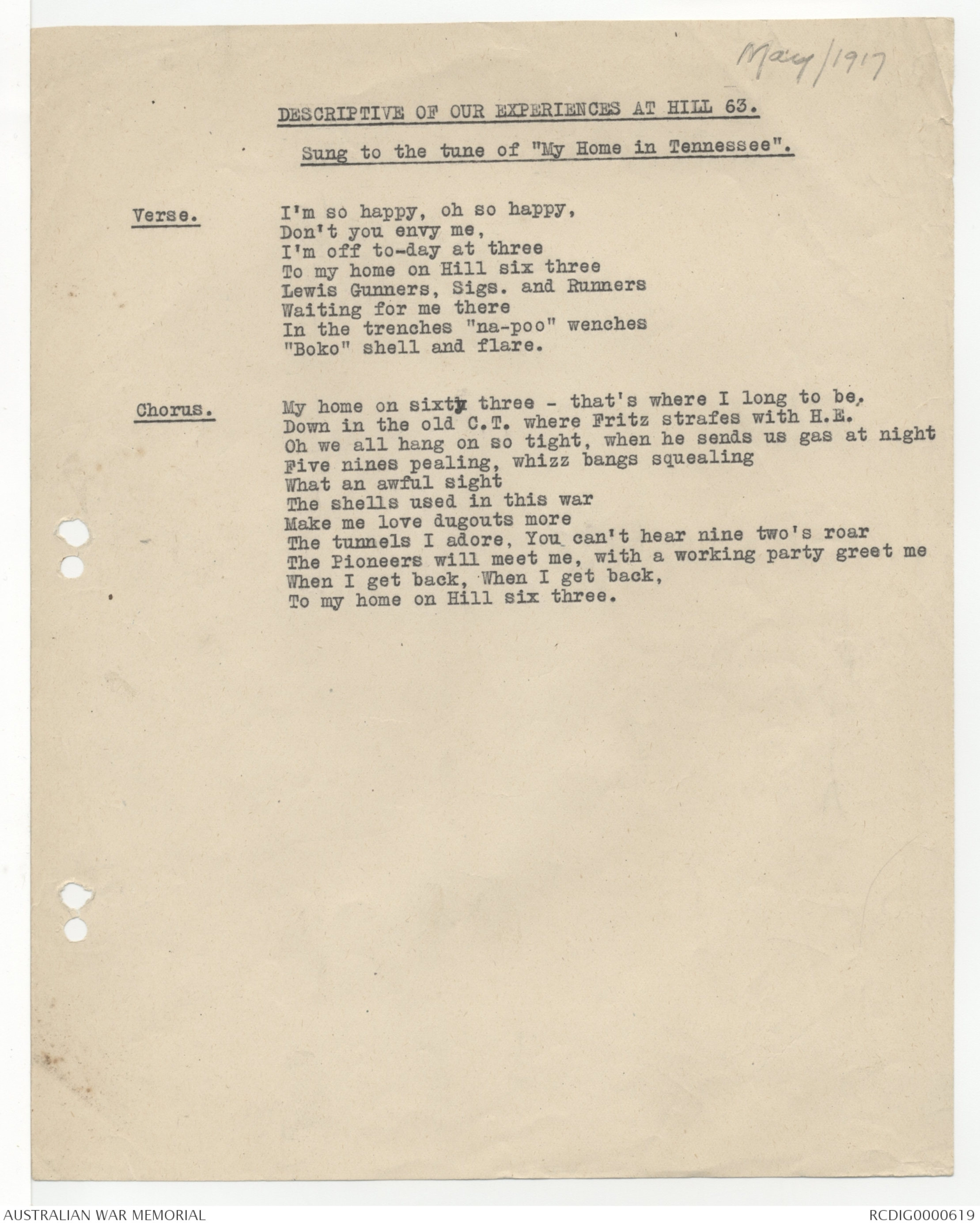
HEADQUARTERS No G1/288
THIRD AUSTRALIAN DIVISION
No. 2.
ADDITIONAL NOTES ON RECENT OPERATIONS CARRIED
OUT BY THE FIRST AND THIRD ARMIES.
27/4/17
One of the Canadian Divisions attributed the success of the operations to attention
paid to the following points:-
1. A good plan, even if an ambitious one.
2. Very careful preparations and instructions.
3. A complete copy of hostile position was marked out, showing, not only the trenches
and prominent features, but also machine gun emplacements, trench mortar emplacements, etc.
All ranks practised rehearsals of the attack on the marked position.
4. A very careful study of the objectives for the attack from captured maps and
photographs. Available information was issued to all ranks.
5. A careful scheme for Infantry observation posts, and means of signalling back
information.
6. A systematic destruction of the hostile trenches by Heavy Artillery, taking portions
of trenches at a time after careful registration. No general shooting at an area by the
Artillery was allowed.
The success of the 106 Fuze as a wire-cutter was very marked.
In order to be quite satisfied that the wire had been effectively cut, the trenches were
cleared 48 hours before zero and the Heavy Artillery turned on the wire with the 106 Fuze
with most satisfactory results.
7. Great care was taken to superintend not only Brigade Orders but Battalion Orders-
with the result that C.Os. had nothing to do once the attack was launched, in spite of the
fact that there was very heavy fighting.
[*?*] 8. A signal should be arranged to stop the final barrage in order to enable patrols to
push forward after the final objective has been gained.
9. The roads leading up to NO MAN'S LAND should be prepared beforehand to carry
Heavy Artillery, and material dumped as far forward as possible to carry the roads forward
at once. Parties for this work must be sufficiently far forward to start work almost
immediately.
10. The weather was very bad: shelters, with water pipes close by, would have been
very useful for erection in the forward area for the Infantry to come to as soon as
relieved.
The men had to come back to dirty dug-outs with little chance of a wash, which they
wanted more than anything else.
C. H. HARINGTON, Major-General,
General Staff, Second Army.
23rd April, 1917
2nd F.S. CO.–1924–500–23-4-17.
[*J.M.
27/4/17
G.OC. copy
Distributed
CRA & Bdes
5 each
26/4/17*]
THIRD AUSTRALIAN DIVISION
Divisional Headquarters,
27/4/17.
C.R.A.
C.R.E.
G.O.C. 9th Aust. Inf. Bde.
G.O.C. 10th -do-
G.O.C. 11th -do-
O.C." 3rd Aust. Pioneer Bn.
O.C. 3rd Aust. Div. Signal Co.
O.C. 3rd Aust. Div. Train.
O.C. 207th Machine Gun Co.
A.D.M.S.
A.D.V.S.
Camp Commandant.
I invite your personal consideration to a question
which is becoming daily more pressing and important in connection
with the Armies in FRANCE. - I allude to the subject of economy
and prevention of waste of rations, and to the extreme importance
of these matters at this critical juncture.
Owing to a shortage of sea freight and the consequent
deficiency of food supplies in the United Kingdom, it may soon
become impossible to maintain the present scale of rations for the
Army. - The undesirable course of reducing the present rations
can only be avoided if we can succeed in instilling into the minds
of all subordinate officers, and of the troops themselves, the
vital necessity of encouraging every possible form of economy and
prevention of waste. This can only be done if Commanders of Units
will take the matter up very seriously and will ensure that all the
officers under their command make a special continuing and sustained
effort to instil into the mind of each individual soldier
a sense of his responsibilities in these matters.
It is well known that a considerable amount of waste
of edible materials is going on, not only because the rations now
actually available are often not consumed at all and are thrown
away, but also because they are not used in the manner to produce
the utmost food value.
Good as the arrangements within this Division have
been in connection with establishment of Field Kitchens, careful preparation
of diet sheets, and getting the utmost food value out of
food supplies, the juncture has arrived when it has become imperative
to exercise even greater pains in all these directions.
The greatest care must be taken that the number of
rations demanded are never in excess of those actually required.
In the event of there being, on any occasion, an overdrawing, and
rations have not been consumed, it is hoped that all concerned will
make it a point of honor to not draw, on subsequent days, to the
extent of unconsumed supplies in hand, so that there may be no
waste. - The possibility of making still more of the authorized
ration should be most carefully studied, the use of the stock
pot should be extended, and everything of value should be saved
whether for food or for fat preservation.
The matter has reached such a position that the
Commander-in-Chief considers it imperative that there shall be a
united and well directed effort throughout the whole Army to reduce
waste to the absolute irreducible minimum.
John Monash.
Major-General,
Commanding Third Australian Division.
28/4/17
DEMONSTRATION.
April 28th. Commencing 1.30 p.m.
1. 4" STOKES MORTARS (on Helfaut Common)
firing:-
(a) Thermite, 48 rounds (4 per gun). Approximate range 450yds.
(b) W.P., 2 rounds only. At maximum range (about 900 yds.)
(c) W.P., 6 rounds only. Air bursts, range about 600 yds.
(d) P.S., 24 rounds (2 per gun). Range about 400 yds.
(e) Smoke Barrage, R.P., Range about 460 yds.
11. (i) PROJECTORS (on Bilques Common)
firing:-
(a) 20 shells filled with oil, to burst, range 500 yds.
(b) 3 Gas Shells, to burst, range 500 yds.
(c) 20 shells filled with oil, to burst, at maximum range
= 1200 yds.
(ii) FLAMMENWERFER.
1 Shot.
Conference
29/4/17
Introductory:-
I Objects of Conference(1) Exposition of all problems which confront us(2) Exchange of views
(3) Interest each in tasks of all remainder(4) Settle minuting Make explanations, & answer questions to save overloading formal orders
New named trenches. —
Later photos — back trenchesAmple new photos — CutlackEngineer Model. —
Commanders as Conduit pipes — full & explicit checking of instructions
provide for Casualties.
7 Don't expose at Chateau Fort - Look out & telescope alidade -
Flank liaison —everywhere.
[*GOC*]
SECRET.
THIRD AUSTRALLAN DIVISION
Divisional Headquarters,
30/4/17.
Notes from Conference at Divisional Headquarters on 29/4/17.
PRESENT.- 3 Infantry Brigadiers, C.R.A., C.R.E., Capt SIMPSON
representing Div. Signal Co., O.C. Pioneer Bn., Major WILLLAMS,
R.E., A.Q., G.S.O.1.
Divisional Commander presided. -
It was ruled that assaulting Battalions and reserve Battalions
were not to be over establishment during the fight, but that
extra duties, e.g., 300 men attached to R.E. Coys., carriers for
Vickers Gun Coys. &c. might be found from personnel surplus to
the fighting establishment.
Discussion as to equipment and munitions to be carried on
the man.
9th Brigade considered 170 rounds should be carried.
10th Brigade do. do. do. except
in the case of those men carrying tools.
11th Brigade thought it most be advisable to adhere exactly
to the suggestions contained in S.S. 135 "Training
of Divisions for offensive action"
The question of provision of calico bandoliers cropped up.
Also the number of rounds to be carried by Lewis Gun personnel.
It was thought they might carry 120 in their equipment.
10th and 11th Brigades considered 50 rounds sufficient
for carrying parties to carry in their equipment.
9th Brigade advocated 120 rounds.
11th Brigade advocated establishment of platoon dumps
formed by collecting loose bandoliers.
All Brigades agreed that Reserve xxxx troops of fighting
Brigades and personnel of Reserve Brigade should carry the same
ammunition as assaulting troops.
[*SS142
Trng of
platoons
Not SS
135*]
All agreed that the average man should carry two bombs.
Carrying parties, no bombs. Bombers as carry numbers as perS.S. 135. Reserves, same as fighting troops. 11th Brigade
being in reserve, to carry 4 bombs each.
9th Brigade thought whole of 2nd wave should carry a pick
or shovel.
10th Bde. thought every platoon should carry 4 picks, and
8 shovels. This only to apply to platoons of G and H Battalions.
11th Bde. thought every man should carry a tool.
Ruling come to was that Picks and shovels should be
carried, but the minimum numbers necessary should be given to
each platoon.
Brigadiers to estimate requirements.
C.R.E. to collect extra tools and make allotment in order
that mobilization stores should, if possible, remain on wheels.
If necessary, however, mobilization stores to be used.
All Brigades agreed that ground sheets should be carried
instead of great-coat, and that 3 to 6 sandbags per man should
be carried, varying in accordance with the duties of the troops.
C.R.E. asked for four platoons for trolleying.
SECRET
-2- 30/4/17.
C.R.A. suggested no wire cutting need be done opposite the mines
This will, of course have to be done in case mines do not work
It was decided thatBrigadiers should receive a copy of letters
written by Divisional Headquarters to G.O.C., R.A. at Corps
with regard to targets.
All Brigades agreed that troops should be in position
of assembly at least one hour before zero.
Barrage timings agreed to as follows.-
Barrage to go down 50 yards in front of enemy's front
line from 0 to plus 2
Remainder of Barrage. - As shown on C.R.A's barrage map,
except that G.S.O.1 and Brigade-Major R?A? are to discuss action
of barrage on General JOBSON's right, and keep it somewhat
closer in.
The question of the final halt being only 150 yards
from our line of consolidation was brought up. – No definite
ruling arrived at.
Position of S.O.S. Barrage during final consolidation
to be considered, i.e. whether to be on UNCANNY TRENCH or closer
in.
Brigadiers to supply from their own Brigades the extra
men for their own Vickers Companies for carrying.
Division to arrange necessary numbers for 207th M.G.Co.
The whole of the 3" Stokes to be at disposal of the
Infantry Brigadiers
10th Brigade asked that 8 sappers might go forward with
their assaulting troops, 9th Bde. 12. These to be attached to
Company Headquarters.
C.R.E. to select and detail. All to be arch-experts in
the siting of trenches.
One Field Co. and one Co. Pioneers to be allotted by
C.R.E. to each Brigade area of assaulting Brigades.
G.S.O. 1, under directions of the Divisional Commander,
to allot areas for work in our own lines to 9th and 10th Bdes
later on when a certain amount of progress has been made.
Brigadiers to consider positions to which they will
withdraw troops to rest after the attack, when no longer required
to hold the new line.
Engineer liaison with Infantry to be most thorough,
C.R.E. to arrange this.
Working strength of a Battalion for Engineer work in preparation
of area prior to the offensive, to be 600 of all ranks.
Allotment to Pioneer Battalion at present to be. –
1 Coy. Trench Mortar positions.
1 Coy. For each attacking Bde. preparatory work
1 Coy. All work in rear.
Brigadiers of assaulting Brigades to take special steps
with regard to flank liaison.
G.S.O. 1 to go into further details with Brigade-Major,
R.A. regarding O.P's in CHATEAU.
SECRET
-3- 30/4/17.
Platoon Commanders not to be allowed to wander over Hill
63 looking at the ground, but to be taken up by officers of their
own Battalions to the CHATEAU. These, in their turn, to be
taken there by Captain SIMONSON.
DISTRIBUTION
G.O.C.
C.R.A.
C.R.E.
9th Aust. Inf. Bde.
10th -do-
11th -do-
File.
[*GHJ LtCol*]
Hand drawn diagram - see original document
30/4/17
301/4/17
[*35x to 20x-15 x -3
295
50 '*]
Notes re Model – to represent say 2500x x 3000x
Scales:- Horizontal 1/100 i.e. 25x x 30x.
Vertical 1/25 or 2 ft difference bet. highest & lowest.
Work to photos. Wherever available.
Show:- trenches – by
roads
Moats
River Douve
Trees
Ruins of Farms
Wire
Our Front lines
Road embankment
Visited Modal with Major Adams
1/5/17
May/1917
DESCRIPTIVE OF OUR EXPERIENCES AT HILL 63.
Sung to the tune of "My Home in Tennessee".
Verse. I'm so happy, oh so happy,
Don't you envy me,
I'm off to-day at three
To my home on Hill six three
Lewis Gunners, Sigs. and Runners
Waiting for me there
In the trenches "na-poo" wenches
"Boko" shell and flare.
Chorus. My home on sixty three - that's where I long to be,
Down in the old C.T. where Fritz strafes with H.E.
Oh we all hang on so tight, when he sends us gas at night
Five nines pealing, whizz bangs squealing
What an awful sight
The shells used in this war
Make me love dugouts more
The tunnels I adore, You can't hear nine two's roar
The Pioneers will meet me, with a working party greet me
When I get back, When I get back,
To my home on Hill six three.
 Deb Parkinson
Deb ParkinsonThis transcription item is now locked to you for editing. To release the lock either Save your changes or Cancel.
This lock will be automatically released after 60 minutes of inactivity.